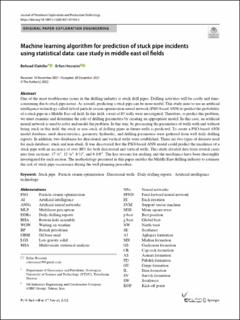| dc.description.abstract | One of the most troublesome issues in the drilling industry is stuck drill pipes. Drilling activities will be costly and time-consuming due to stuck pipe issues. As a result, predicting a stuck pipe can be more useful. This study aims to use an artificial intelligence technology called hybrid particle swarm optimization neural network (PSO-based ANN) to predict the probability of a stuck pipe in a Middle East oil field. In this field, a total of 85 wells were investigated. Therefore, to predict this problem, we must examine and determine the role of drilling parameters by creating an appropriate model. In this case, an artificial neural network is used to solve and model the problem. In this way, by processing the parameters of wells with and without being stuck in this field, the stuck or non-stuck of drilling pipes in future wells is predicted. To create a PSO-based ANN model database, mud characteristics, geometry, hydraulic, and drilling parameters were gathered from well daily drilling reports. In addition, two databases for directional and vertical wells were established. There are two types of datasets used for each database: stuck and non-stuck. It was discovered that the PSO-based ANN model could predict the incidence of a stuck pipe with an accuracy of over 80% for both directional and vertical wells. This study divided data from several cases into four sections: 17 ½″, 12 ¼″, 8 ½″, and 6 1/8″. The key reasons for sticking and the mechanics have been thoroughly investigated for each section. The methodology presented in this paper enables the Middle East drilling industry to estimate the risk of stuck pipe occurrence during the well planning procedure. | en_US |

